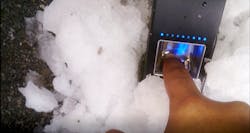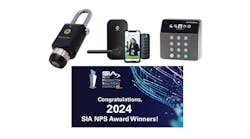Although automatic identification based on physiological or behavioral characteristics has been around since the 70s, it is only now beginning to move into widespread commercial use. The challenge for the locksmith is to discover reliable biometric products that can serve customers well, help you make a living, and protect your reputation.
If you can hook-up an electrified lock, magnet or strike, you can now provide your bread and butter customers the latest and most sophisticated biometric solutions. These are solutions that will work, and make your customers the envy of their friends – and enemies.
In the past, many biometric applications tended to be more “gee whiz” and less practical. Indeed, biometrics along with PIN or card could improve confidence that the person at the door was indeed the right one. Unfortunately, throughput requirements, environmental restrictions, reliability, and high costs limited access control applications.
The good news for the professional locksmith is that much has changed. An excellent article in the July 2017 Locksmith Ledger discusses some of your best target markets. (Is This The Year To Consider Biometrics? www.locksmithledger.com/12341064A) A December 2015 article provides additional background, as well. (Biometric Basics, www.locksmithledger.com/12133379.
Here, we’ll discuss two dramatic breakthroughs that are revolutionizing the field. Biometrics fall into two broad categories: Physical and Behavioral.
Behavioral biometrics currently include: Voice Recognition, Signature Dynamics, and Keystroke Patterns. Behavioral patterns are currently used to identify suspicious behavior, but we have not yet seen them integrated into Access Control applications. On the other hand, Fingerprint and Facial Recognition appear to be the two maturing technologies.
Physical biometrics include Fingerprint, Facial Recognition, Hand Geometry, Iris Scan, and Retina Scan. Most Access Control industry effort has been focused in this area.
- Hand Geometry first emerged in the mid 80s as a reliable and robust biometric technology. The scanner measured the length and thickness of various finger components, and sometimes the palm. High cost, large size and slow throughput tended to limit this technology’s growth.
- Retina Scan has also had some commercial success. This measures the unique blood vessel patterns on the retina at the back of the eye. Again, cost, throughput, and fear of putting something close to the eye have tended to limit application to only the most secure sites.
- Iris scanners don’t require such close scrutiny, since the iris is located at the front and easily seen by the reader. It is less intrusive and throughput a bit faster.
The big news is that Facial and Fingerprint recognition have made dramatic improvements in cost, throughput speed, reliability, and the ability to function in challenging environments. FAR (False Acceptance Rates) and FRR (False Rejection Rates) that have plagued these biometrics in the past, have been seriously improved.
Near-Infrared Facial Recognition
Facial Recognition had its early challenges. Finding a terrorist at the Superbowl looked good in the movies, but the reality was far less convincing. Connectivity, lighting, resolution and diverse design criteria created reliability and cost problems. Early video or photo-based systems attempting to identify a face from a photograph, a YouTube video, in a crowd, or an uncooperative person did not provide adequate accuracy for use in the Access Control market.
A Kansas based company called StoneLock® pioneered a single purpose Near-Infrared spectrum Facial Recognition (NIR) reader that has moved this technology from “bleeding edge” to reliable commercial application. The reader can identify and authorize an approaching person from several feet away.
Two major elements make the StoneLock technology actually work reliably in the field. First off, the LED-produced Near-Infrared wavelengths are invisible to the naked eye and relatively unaffected by normal ambient light or temperature.
The NIR looks deeper into the facial tissue, allowing sub dermal spectroscopic measurements and minimizing external factors that limit a normal camera. It allows a fast, accurate measurement of unique facial characteristics, using more than 2,000 separate data points. The NIR light source can read from total darkness to near full sunlight, although it is not currently rated for outdoor applications, rain or bright sunlight.
The second element is the human tendency to look at itself in a mirror. A small camera and monitor allow the subject to see itself on the screen, and quickly center the picture for a rapid throughput process. When the face is seen, measurement time is 10ms and record match time is less than 0.002ms. On the StoneLock website, a video shows people transiting the Facial Recognition reader at a very rapid rate. https://www.stonelock.com/stonelockpro/
The technology is rated at less than 0.0004 percent False Acceptance Rate, but a False Acceptance has never been reported in actual use. False Rejection Rates have been a non-issue as re-scans happen so fast that the user is unaware of the few-millisecond process.
Second and third level validation is available with an embedded HID® card, keypad, or any combination. This facial recognition process has been validated in a large number of field installations and is currently being used by major integrators world-wide. Enrollment takes just seconds.
“Privacy is strengthened since there are no facial images or personal identifiers,” according to StoneLock Co-Founder David Dunlap. “Don’t worry about sharing your picture with the National Security Agency. There is no picture; just 2000 data points that recognize the enrollee,” he asserted.
Multi-Spectral Fingerprint Readers
Fingerprint Readers have also undergone massive improvements. Many consumer electronics users have had frustrating experiences with fingerprint readers that worked – sometimes after two or three (or more) tries. Positioning, scratches on the reader head or finger, dirt, grease, or skin surface oils and dimples all contributed to rejections.
Optical scanner, Capacitance sensor and Multi Spectral Image sensors are the three technologies currently in use. The first two use a light or electrical charge to map the finger’s ridges. Capacitance readers are more tolerant of dirt and grease, and can be flush mounted as they don’t need to block ambient light. Optical scanners are popular in less demanding environments. These technologies work well in many environments. Be sure to discuss the application with the manufacturer to verify that you order the most cost-effective technology for your customer.
The revolutionary Lumidigm® Multi Spectral Imaging technology (acquired by the HID division of ASSA ABLOY) has dramatically improved the fingerprint reader by examining surface as well as subsurface properties.
The Multi Spectral light source examines the finger surface as well as the capillary tufts and dermal papillae that lie below the fingerprint ridges. The subsurface pattern continues to exist, even when the surface pattern is deformed or damaged. It also captures more of the finger and gives a far clearer and consistent image.
Research projects successfully tested Multi-Spectral read heads for adverse conditions, including the use of acetone, chalk, dirt, water, low finger pressure, and bright ambient light. Previously demonstrated spoofing techniques, such as breathing on the sensor to reactivate a latent image, using a cadaver finger, and replica prints made with tape, graphite powder, silicone, gelatin, or a rubber stamp, were all unsuccessful. The reader is so effective that it functions in snow, dirt, grease, water, and through surgical gloves.
At an oil refinery in Africa with 80,000 workers, Access Control manufacturer Invixium successfully applied the Multi Spectral technology at 53 access points. Employees use dual factor authentication (with HID Prox cards) for access. Toronto based Invixium plans to add facial recognition options soon as well. HID’s iCLASS SE® reader and SekureID® are also using the Multi Spectral fingerprint technology, and others are sure to follow as the robust technology becomes known.
The good news for the locksmith is that we now have two spectacular new technologies that work well in high-traffic and harsh environments. The new NIR Facial Recognition is fast enough for high-traffic indoor or covered turnstiles while the Multi Spectral Fingerprint readers work well in outdoor and harsh environments. Optical and Capacitance scanners continue to be used in less demanding traffic and environmental situations where initial cost is more of a concern.
Other biometric readers are offered by familiar brands. MorphoAccess®, offers the SIGMA Lite multi-technology series that reads, fingerprints, RFID cards, or PIN codes. Keri Systems, and Seco-Larm are offering wall-mounted biometric readers for Access Control Applications. Most of these are available from your traditional wholesale resources, or direct from the manufacturer.
Built-in Biometrics are represented by the Westinghouse® RTS line, using Grade I cylindrical and Grade II tubular locks made by Milwaukee based STRATTEC.
ZKAccess®, is a Fairfield NJ division of China based ZKTeco. They offer the Grade II tubular lock with built-in battery operated fingerprint reader or its fast and accurate wall mounted SilkID fingerprint reader. They also offer facial recognition and a number of other access control and T&A applications.
Residential applications are also available with a number of Grade III locksets and lower cost fingerprint readers. Many are available from Amazon, Home Depot, and others catering to the D.I.Y market. Samsung has a hospital latch type biometric lock that is top rated by several reviewers. They also have a lever operated version. Other residential applications include: Adel 3398, iTouchless Bio-Matic, ZKTeco PL10B, the NextBolt NX4. Street prices for residential locks range from about $200 to $500.
Biometrics are not likely to replace the prox card or fob in the immediate future, but do offer solid solutions where dual authentication or a higher level of certainty is required. Research labs, transportation, and utility infrastructure sites increasingly present biometric market opportunities. The new biometric technologies now allow you to sell and install with confidence.
Cameron Sharpe CPP, [email protected], worked in marketing for Caterpillar and Honeywell before serving 25-years with Best Lock Corporation in New Jersey and Arizona.






